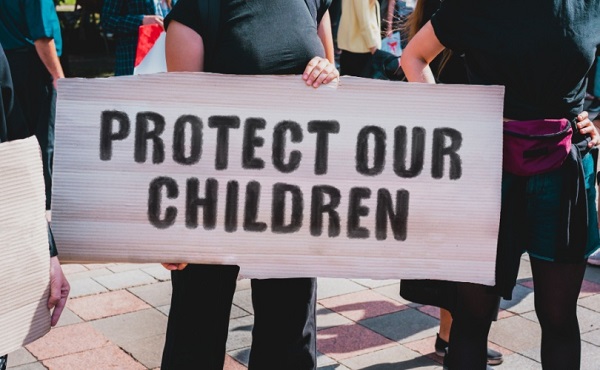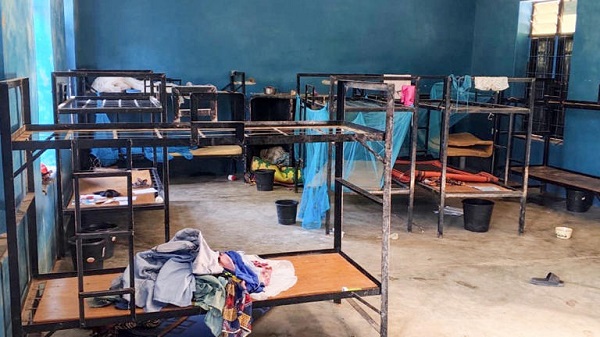Alberta
Oil sands technology competition to generate low emissions carbon fibre moves into final phase

Bryan Helfenbaum, associate vice-president of clean energy with Alberta Innovates, holds a hockey stick made with carbon fibre derived from oil sands bitumen. Photo by Dave Chidley for the Canadian Energy Centre
From the Canadian Energy Centre
By Will Gibson and Deborah Jaremko
Study found carbon fibre made from oil sands bitumen has 69 per cent lower emissions than conventional sources
Having spent most of a long and distinguished academic career working with metals, Weixing Chen became fascinated by the potential of repurposing a heavy hydrocarbon from Alberta’s oil sands into a high-value product for a low-carbon economy.
The product is carbon fibre – thin as human hair but four times stronger than steel – and research has shown producing it from oil sands bitumen generates lower greenhouse gas emissions than today’s sources.
“This is a great opportunity for me to challenge myself moving forward to develop this technology that will benefit society,” says Chen, a chemical and material engineering professor at the University of Alberta.
His team at Edmonton-based Thread Innovations is one of five receiving a total $15 million in funding in the final round of the Carbon Fibre Grand Challenge, announced in December.
Great potential for carbon fibre
With its light weight and high strength, today carbon fibre is used in products like aircraft and spacecraft parts, racing car bodies, bicycles, hockey sticks and golf clubs.
It has great potential, but its use is limited by cost. Carbon fibre averages $10 to $12 per pound, compared to less than $1 per pound for steel.
Part of the Alberta competition is that the carbon fibre derived from oil sands bitumen must cost 50 per cent less than current carbon fibre products.
This would unlock new markets for carbon fibre, says Byran Helfenbaum, associate vice-president of clean energy for Alberta Innovates, which is funding the challenge along with Emissions Reduction Alberta.
“At the end of this phase, the intention is the technology is at a point where a company could make a funding decision for if not a commercial project, then at least a commercial demonstration project,” he says.
“It’s really to get it out of the lab and start hitting the key specifications, identifying the existing and new markets, and pumping out prototypes that can be tested. We have already generated our first two prototypes, a truck side mirror and a hockey stick, but we need to go bigger and faster and test a wide range of market opportunities.”
Long-term need for carbon-based products
The future is likely to be full of carbon fibre products, Helfenbaum says.
“This ‘low-carbon future’ is a misnomer. When we say low-carbon future, what we mean is let’s keep carbon out of the atmosphere. Carbon is still going to be around us in solid form, and probably in increasingly higher amounts,” he says.
“We’re going to have 10 billion people on the planet by mid-century. They need energy, but they also need stuff. They need housing, infrastructure, and consumer goods. And most of that stuff is or can be made of pure carbon.”
Lower emissions from oil sands carbon fibre
Most carbon fibre today is generated from a chemical compound called polyacrylonitrile (PAN), which is derived from a component of natural gas.
A recent study by researchers at the University of Alberta found that life cycle emissions from carbon fibre derived from oil sands bitumen are 69 per cent lower than PAN-based product.
It’s the high carbon content of oil sands bitumen that provides the benefit, Helfenbaum says.
“The heaviest fraction of bitumen takes more energy to break down to be turned into fuels. But that same fraction can be used to produce carbon fibre with fewer greenhouse gas emissions than the current PAN process,” he says.
“If we are successful in reducing its cost, then it can be deployed into new markets that will further reduce carbon emissions, such as lightening passenger vehicles and improving the longevity of concrete infrastructure.”
Adding value while reducing emissions
The Carbon Fibre Grand Challenge is part of Alberta Innovates’ broader Bitumen Beyond Combustion research program. The work considers opportunities to use bitumen to create value-added products other than fuels like gasoline and diesel.
“From an economic perspective, the Bitumen Beyond Combustion program could triple the value of a barrel of bitumen,” Helfenbaum says.
“Carbon fibre is among the most valuable of those products, but it’s not the only one. This is potentially in the tens of billions of dollars a year of gross revenue opportunity, so this is transformational.”
It also presents environmental benefits.
“Eighty per cent of the emissions associated with petroleum happen at combustion of gasoline, diesel, and jet fuel so by diverting into these products, that becomes carbon that is sequestered forever and doesn’t get into the atmosphere,” he says.
Pathway to commercial production
Winners of the grand challenge will have a credible pathway to manufacturing 2,000 tonnes or more of carbon fibre per year. The challenge is scheduled to end in summer 2026.
Thread Innovations is building a new facility to produce samples for potential buyers and demonstrate the ability to scale up production. This phase will also focus on improving characteristics of the carbon fibre produced by their technology to build commercial demand.
“Our target is to complete the current project and then establish a commercialization plan in 2025,” says Chen.
Alberta
New pipeline from Alberta would benefit all Canadians—despite claims from B.C. premier

From the Fraser Institute
The pending Memorandum of Understanding between the Carney government and the Alberta governments will reportedly support a new oil pipeline from Alberta’s oilsands to British Columbia’s tidewater. But B.C. Premier David Eby continues his increasingly strident—and factually challenged—opposition to the whole idea.
Eby’s arguments against a new pipeline are simply illogical and technically incorrect.
First, he argues that any pipeline would pose unmitigated risks to B.C.’s coastal environment, but this is wrong for several reasons. The history of oil transport off of Canada’s coasts is one of incredible safety, whether of Canadian or foreign origin, long predating federal Bill C-48’s tanker ban. New pipelines and additional transport of oil from (and along) B.C. coastal waters is likely very low environmental risk. In the meantime, a regular stream of oil tankers and large fuel-capacity ships have been cruising up and down the B.C. coast between Alaska and U.S. west coast ports for decades with great safety records.
Next, Eby argues that B.C.’s First Nations people oppose any such pipeline and will torpedo energy projects in B.C. But in reality, based on the history of the recently completed Trans Mountain Expansion (TMX) pipeline, First Nations opposition is quite contingent. The TMX project had signed 43 mutual benefit/participation agreements with Indigenous groups along its route by 2018, 33 of which were in B.C. As of March 2023, the project had signed agreements with 81 out of 129 Indigenous community groups along the route worth $657 million, and the project had resulted in more than $4.8 billion in contracts with Indigenous businesses.
Back in 2019, another proposed energy project garnered serious interest among First Nations groups. The First Nations-proposed Eagle Spirit Energy Corridor, aimed to connect Alberta’s oilpatch to a port in Kitimat, B.C. (and ultimately overseas markets) had the buy-in of 35 First Nations groups along the proposed corridor, with equity-sharing agreements floated with 400 others. Energy Spirit, unfortunately, died in regulatory strangulation in the Trudeau government’s revised environmental assessment process, and with the passage of the B.C. tanker ban.
Premier Eby is perfectly free to opine and oppose the very thought of oil pipelines crossing B.C. But the Supreme Court of Canada has already ruled in a case about the TMX pipeline that B.C. does not have the authority to block infrastructure of national importance such as pipelines.
And it’s unreasonable and corrosive to public policy in Canada for leading government figures to adopt positions on important elements of public policy that are simply false, in blatant contradiction to recorded history and fact. Fact—if the energy industry is allowed to move oil reserves to markets other than the United States, this would be in the economic interest of all Canadians including those in B.C.
It must be repeated. Premier Eby’s objections to another Alberta pipeline are rooted in fallacy, not fact, and should be discounted by the federal government as it plans an agreement that would enable a project of national importance.
Alberta
Premier Danielle Smith says attacks on Alberta’s pro-family laws ‘show we’ve succeeded in a lot of ways’

From LifeSiteNews
Recent legislation to dial back ‘woke progressivism’ is intended to protect the rights of parents and children despite opposition from the left.
Alberta Premier Danielle Smith took a shot at “woke progressivism” and detractors of her recent pro-family laws, noting that because wokeness went “too far,” the “dial” has turned in favor of parental rights and “no one” wants their “kid to transition behind their back.”
“We know that things went a little bit too far with woke progressivism on so many fronts and we’re trying to get back to the center, trying to get them back to the middle,” Smith said in a recent video message posted on the ruling United Conservative Party’s (UCP) official X account.
Smith, who has been battling the leftist opposition New Democratic Party (NDP) attacks on her recent pro-family legislation, noted how “we’ve succeeded in a lot of ways.”
“I think we have moved the dial on protecting children and the right of girls and women to participate in sports without having to face born male athletes,” mentioning that the Olympics just announced gender-confused athletes are not allowed to compete in male or female categories.
“I think we’re moving the dial on parental rights to make sure that they know what’s going on with their kids. No one wants their kid to be transitioned behind their back and not know. I mean, it doesn’t matter what your background is, you want to know what’s going on with your child.”
Smith also highlighted how conservatives have “changed the entire energy conversation in the country, we now have we now have more than 70 percent of Canadians saying they believe we should build pipelines, and that we should be an energy superpower.’
As reported by LifeSiteNews, Smith recently said her government will use a rare constitutional tool, the notwithstanding clause, to ensure three bills passed this year – a ban on transgender surgery for minors, stopping men from competing in women’s sports, and protecting kids from extreme aspects of the LGBT agenda – remain law after legal attacks from extremist activists.
Bill 26 was passed in December 2024, amending the Health Act to “prohibit regulated health professionals from performing sex reassignment surgeries on minors.”
Last year, Smith’s government also passed Bill 27, a law banning schools from hiding a child’s pronoun changes at school that will help protect kids from the extreme aspects of the LGBT agenda.
Bill 27 will also empower the education minister to, in effect, stop the spread of extreme forms of pro-LGBT ideology or anything else allowed to be taught in schools via third parties.
Bill 29, which became law last December, bans gender-confused men from competing in women’s sports, the first legislation of its kind in Canada. The law applies to all school boards, universities, and provincial sports organizations.
Alberta’s notwithstanding clause is like all other provinces’ clauses and was a condition Alberta agreed to before it signed onto the nation’s 1982 constitution.
-

 Alberta1 day ago
Alberta1 day agoPremier Smith explains how private clinics will be introduced in Alberta
-

 Censorship Industrial Complex2 days ago
Censorship Industrial Complex2 days agoUK Government “Resist” Program Monitors Citizens’ Online Posts
-

 Bruce Dowbiggin2 days ago
Bruce Dowbiggin2 days agoElbows Down For The Not-So-Magnificent Seven: Canada’s Wilting NHL Septet
-

 Business1 day ago
Business1 day agoUS Supreme Court may end ‘emergency’ tariffs, but that won’t stop the President
-

 International1 day ago
International1 day ago“The Largest Funder of Al-Shabaab Is the Minnesota Taxpayer”
-

 Alberta1 day ago
Alberta1 day agoAlberta introducing dual practice health care model to increase options and shorten wait times while promising protection for publicly funded services
-

 International1 day ago
International1 day ago50 of the 315 students and 12 staff abducted from Catholic school in Nigeria last week have escaped
-

 espionage1 day ago
espionage1 day agoSoros family has been working with State Department for 50 years, WikiLeaks shows






